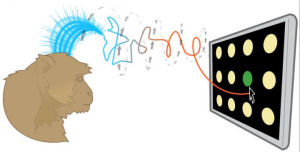
The longstanding belief that each of the brain’s 100 billion neurons communicate strictly by a digital code looks to be incorrect. Writing in Nature, Yale neurologist David McCormick reported that communicating brain cells use a mix of analog and digital coding at the same time. “This study reveals that the brain is very sophisticated in its operation, using a code that is more efficient than previously appreciated,” said McCormick.
The brain’s neurons receive input from other cells through synaptic contacts which release neurotransmitters that cause the voltage inside the neuron to fluctuate continuously. Once this voltage reaches a threshold, an action potential is generated, which causes a specialized waveform to travel down the axon and create an output signal. It was previously believed that this specific waveform was the only output signal that axons were capable of transmitting.
But McCormick and his co-researchers demonstrated that the analog signal present in the cell body also propagates down the axon and influences synaptic transmission onto other neurons.
“This has widespread implications, not only for our basic understanding of how the brain operates, but also in our understanding of neuronal dysfunction,” said McCormick. “It’s as if everyone thought communication in the brain was like a telegraph, but actually it turned out to be more similar to a telephone.”
The discovery may help explain epileptic seizures and migraine headaches, which both involve large voltage changes in neurons. These abnormal patterns of activity could be directly communicated to nearby neurons – even in the absence of the generation of the usual communication waveform.
The finding will also impact scientists trying to understand how consciousness and intelligence manifest in the human brain, as any investigation into neuronal operation will now need to take into account the mixed analog-digital nature of neuron communication.








Comments are closed.